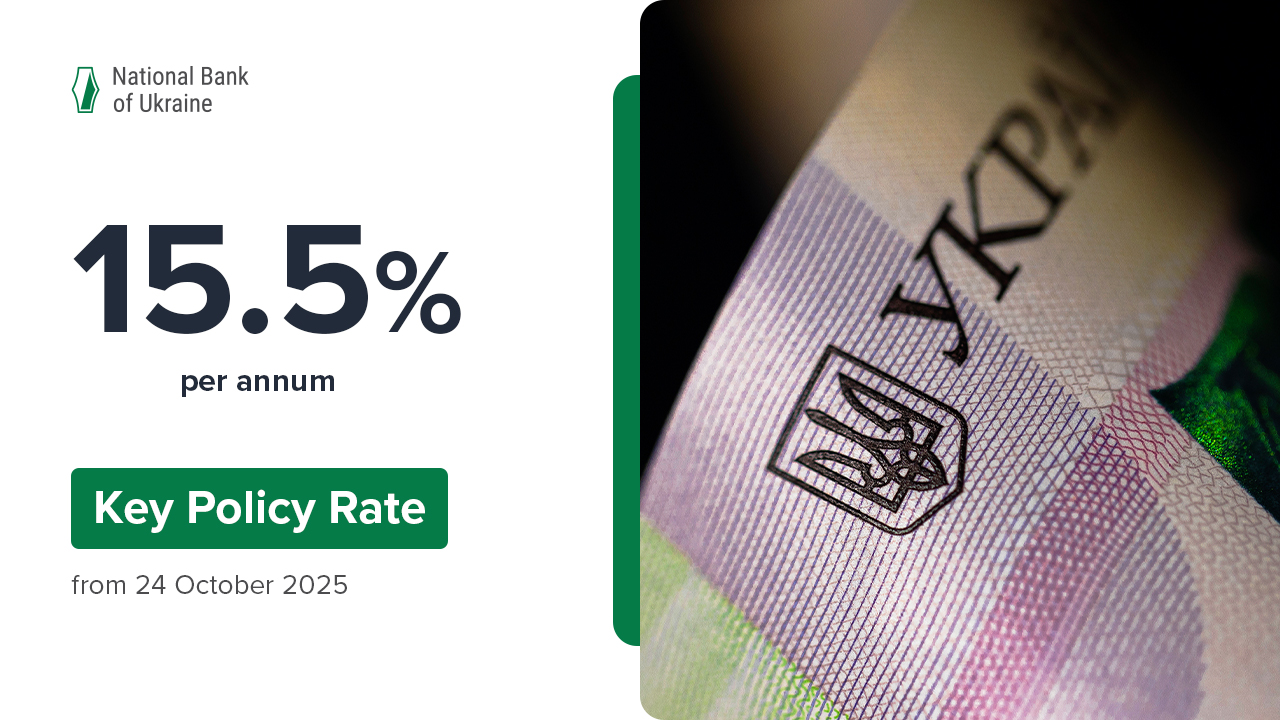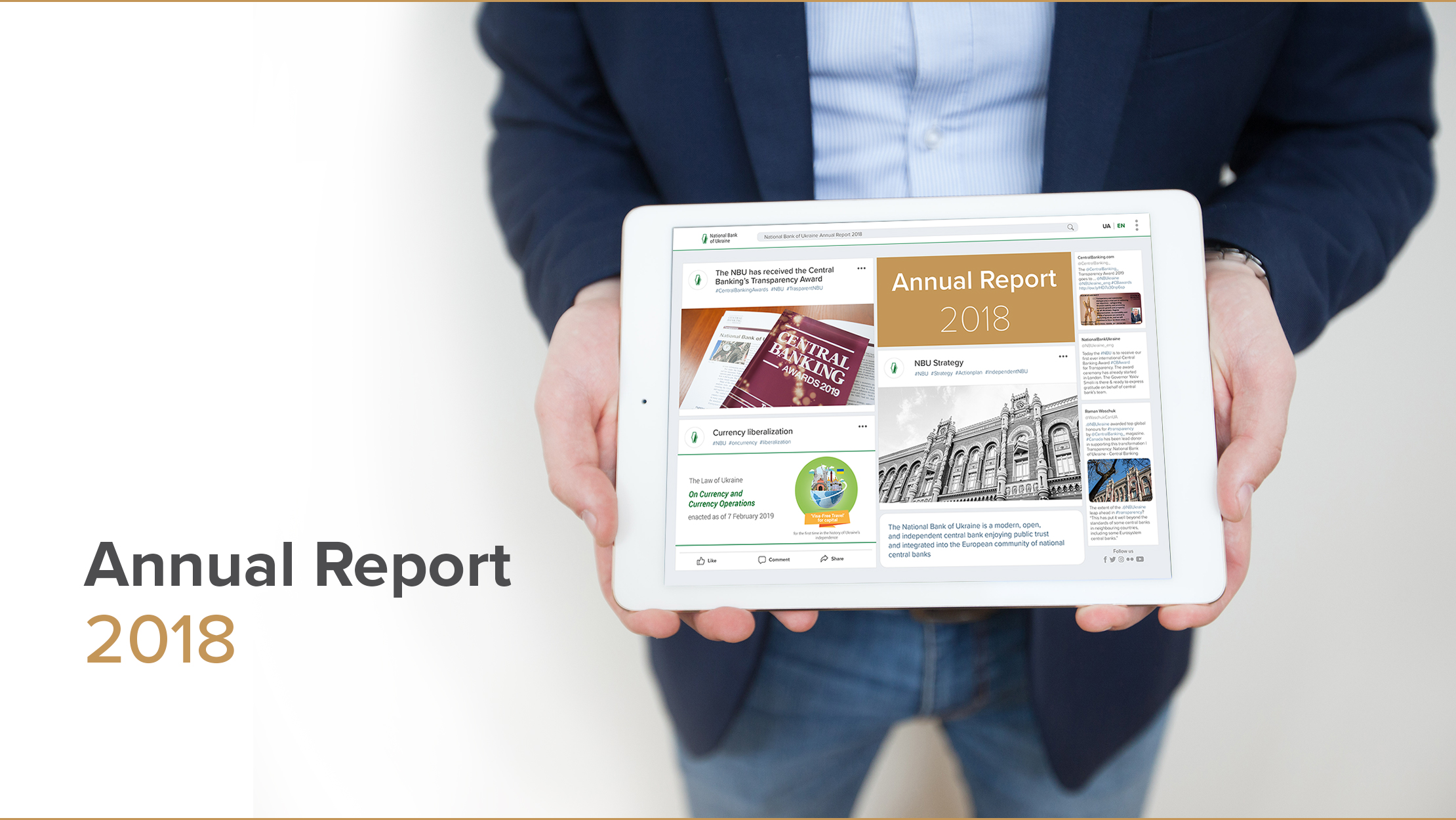The National Bank of Ukraine has published its 2018 Annual Report, presenting, for the first time in its history, the results of the implementation of its mid-term strategy. The NBU strategy, which was adopted in the spring of 2018, outlined seven key objectives for the years to come, along with ways to achieve these objectives, criteria and deadlines for meeting these objectives, key activities, and quantifiable outcomes.
Inspiration for this report came from the prestigious central banking award the NBU was awarded in 2018 by the international community for transparency and creating open dialogue with its customers and partners. The NBU’s strategy has become one of the main ways to highlight the central bank’s commitment to transparency and efficiency in pursuing its mandate.
“The publication of the Annual Report, in which the NBU presented the annual results of its operations to the general public, was another key move that highlighted the central bank’s openness,” said Director of Communications Department Nataliia Bondarenko. “That’s why the NBU chose transparency as the visual theme for this report. This reports provides readers with links to social networks, where each reader is a social medium. The NBU, which actively communicates in five social media, is no exception.”
The strategy is not a declaratory document, as each chapter of the Annual Report is a report by the NBU to the general public about what the central bank did to implement its mandate and to meet its strategic goals in 2018.
Objective 1. Low and stable inflation
In 2018, inflation dropped to 9.8% yoy, the lowest figure in the last five years. This was mainly the result of the central bank’s tight monetary policy. Last year, the regulator raised the key policy rate four times, by a total of 3.5 pp, to 18% per annum, in response to inflationary factors.
Inflation will continue to gradually decline. The NBU expects that inflation will drop to 6.3% by the end of 2019, entering the target range of 5%± 1 pp in early 2020, and reaching the 5% target in late 2020. Low and stable inflation will lay the groundwork for the sustainable growth of the Ukrainian economy.
International reserves hit a five-year high in 2018, totaling USD 20.8 billion in early 2019. Favorable FX market conditions enabled the NBU to replenish Ukraine’s international reserves.
Objective 2. A stable, transparent, and effective banking system
In 2018, the banking sector made a net profit of UAH 21.7 billion, the highest level in over a decade. In contrast, in 2017, the banking sector sustained losses of UAH 20 billion. This was the first year in which the profit figure was real, and not achieved by banks not reporting actual loan loss provisions. The number of lossmaking financial institutions decreased to 13 banks, down from 18 banks last year.
Hryvnia household deposits increased by 14.8% in 2018. Deposits grew the most in H1, whereas growth was more volatile in H2 due to changes in the exchange rate and interest rates. Hryvnia corporate deposits grew by 6.8% yoy.
Objective 3. The resumption of lending
Lending to reliable corporate borrowers grew at a fast clip. Hryvnia deposits to businesses that did not default from 2014 through 2018 were up by 25.8% yoy. In general, net hryvnia loans to corporate customers increased by 8.1% in 2018, especially in privately owned (by 17.6%) and foreign banks (by 7.6%).
The growth of retail lending remained high, at 34.1% yoy for hryvnia loans excluding provisions. The highest growth rates were reported by privately owned (54.2% yoy) and state-owned banks (49% yoy). Consumer loans rose at the fastest pace.
Objective 4. Effective regulation of the financial sector
Being the potential regulator of the larger portion of the non-bank financial market, once the functions of the National Financial Services Commission are divided, in 2018 the NBU drew up and presented for public discussion a draft program for the future regulation of this market. The NBU presented its vision in a draft white paper entitled “The Future of Regulating the Nonbank Financial Sector.” Among other things, the NBU outlined three clear-cur requirements for non-bank financial market participants: clear ownership structure, complying with AML/CFT laws, and meeting capital adequacy ratios.
Objective 5. Free flow of capital
The key event in 2018 in supporting the free flow of capital was the approval in June by the Ukrainian parliament of the draft law On Currency and Currency Operations, drawn up by the National Bank of Ukraine jointly with experts of the European Commission, and supported by the relevant parliamentary committees. In complying with this law, the NBU developed a new liberal and transparent system of FX controls, which consists of eight main resolutions issued by the NBU Board. Almost 30 currency restrictions – that for years restrained business development and investment inflow – were cancelled once the law took effect on 7 February 2019.
Objective 6. Financial inclusion
The share of cashless operations in total operations involving payment cards moved up to 45.1% in 2018. Overall, in 2018, holders of payment cards issued by Ukrainian banks carried out 3.9 billion transactions, while the volume of these transactions rose by one third, to UAH 2.8765 billion.
Objective 7. A modern, open, independent, and effective central bank
The world’s most advanced central banks recognize that they cannot effectively implement policy without having strong communications. The NBU views communications as one of its strategic functions. The NBU’s new Communications Strategy, approved in late 2018, aims to increase the effectiveness of the central bank’s communications with the general public. The NBU communicates what it does and why, and how its decisions affect both the lives of individuals and the development of the Ukrainian economy. The strategy has three main objectives: bolstering confidence in the central bank, maximizing influence on the behavior of economic agents, and minimizing information asymmetries and decreasing uncertainty in the economy by ensuring that its target audiences have access to the information they need to make informed decisions.
In 2018, the NBU also improved its communications with the Ukrainian parliament, the Cabinet of Ministers of Ukraine, and relevant ministries. The Financial Stability Board, which is the key platform for coordinating the economic reform efforts of financial sector regulators, held four meetings during the year. The NBU’s active involvement and close cooperation with the Ukrainian parliament contributed to the adoption of five important laws that will help further develop Ukraine’s financial services market.
You can find more details about the key indicators of the NBU’s operations in the 2018 Annual Report.
Consolidated financial statements and the consolidated governance report, as well as the auditor's report, are available at the following link.
For reference
Compiling and disseminating annual reports is common practice for all central banks. The NBU’s consolidated financial statements comprise an integral part of the Annual Report. The NBU had its financial statements audited by the international auditing company Deloitte, a member company of Deloitte Touche Tohmatsu Limited.
The NBU has been publishing annual reports since 1994.
Annual reports for 1994 through 2018 are available on the NBU’s official website. The central bank has digitized all of the paper versions of the annual reports, starting from 1994. The electronic versions of these reports are available on the NBU’s official website.







